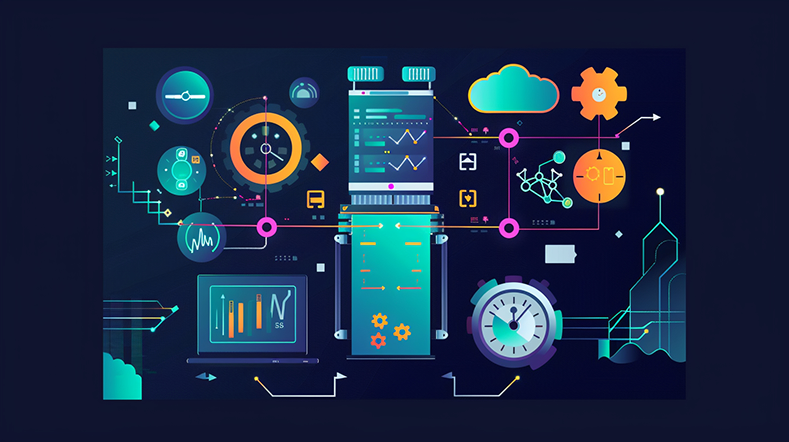Big Data with Hadoop: Top 10 FAQs Answered
Last updated on July 14th, 2024 at 10:57 am
What is Hadoop and How Does It Relate to Big Data?
In the realm of big data, Hadoop has emerged as a cornerstone technology, revolutionizing the way organizations store, process, and analyze vast amounts of data. But what exactly is Hadoop, and how does it relate to big data?
Hadoop is an open-source distributed computing framework designed to handle large datasets. It consists of the Hadoop Distributed File System (HDFS) for data storage and MapReduce for parallel data processing. These components work together to manage and analyze data efficiently across a cluster of commodity hardware.
The Hadoop ecosystem includes various tools that enhance its functionality. HBase provides real-time database operations, Hive offers SQL-like querying capabilities, Pig simplifies data processing with a high-level scripting language, and Spark enables in-memory processing for fast analytics.
Hadoop plays a crucial role in big data by addressing the challenges of storing and processing large volumes of diverse data sources. Its scalability, fault tolerance, and cost-effectiveness make it ideal for managing the three V’s of big data: volume, velocity, and variety.
Key benefits of using Hadoop for big data analytics include:
- Scalability: Easily scale your data processing capabilities by adding more nodes.
- Cost-Effectiveness: Leverage commodity hardware and open-source software to reduce costs.
- Flexibility: Support for various data types and processing tasks.
- Real-Time Analytics: Perform real-time processing and gain immediate insights.
- Fault Tolerance: Ensure data reliability with HDFS replication.
In summary, Hadoop provides a scalable, reliable, and cost-effective platform for big data analytics. Its distributed architecture and rich ecosystem of tools make it an indispensable asset for organizations looking to harness the power of big data.
Read more: Understanding Hadoop and Its Role in Big Data

How Does Hadoop Handle Large-Scale Data Processing?
Large-scale data processing presents challenges like managing massive data volumes, complex analytics, and ensuring scalability and reliability. Hadoop, with its distributed computing framework and ecosystem of tools, offers robust solutions for these tasks. Here’s how Hadoop manages large-scale data processing:
Distributed Storage and Processing: Hadoop Distributed File System (HDFS) splits large datasets into smaller blocks distributed across a cluster. MapReduce processes data in parallel across multiple nodes.
Scalability: Hadoop’s architecture allows easy scaling by adding nodes to increase storage and processing power as data volumes grow.
Fault Tolerance: HDFS replicates data blocks across multiple nodes, ensuring data availability despite node failures. MapReduce automatically retries failed tasks.
Parallel Processing: MapReduce enables parallel data processing by dividing tasks into sub-tasks executed across multiple nodes, leveraging the cluster’s computing power.
Data Locality Optimization: Hadoop processes data where it is stored, minimizing network data movement, reducing latency, and improving efficiency.
Resource Management: YARN dynamically allocates resources based on job requirements, optimizing resource utilization and cluster performance.
In summary, Hadoop’s distributed architecture, fault tolerance, scalability, and parallel processing capabilities make it ideal for handling large-scale data processing efficiently. This enables organizations to derive valuable insights and drive growth.
Read more: How Hadoop Handles Large-Scale Data Processing

Benefits of Using Hadoop for Big Data Analytics
In today’s data-driven world, organizations seek to harness big data analytics for insights, innovation, and competitiveness. Hadoop has emerged as a key technology in this realm, offering several benefits that help organizations unlock their data’s full potential. Here are the key benefits of using Hadoop for big data analytics:
Scalability: Hadoop’s distributed architecture allows seamless scaling by adding nodes, enabling organizations to handle growing data volumes without compromising performance or reliability.
Cost-Effectiveness: Leveraging commodity hardware and open-source software, Hadoop significantly reduces infrastructure and software costs. Its scalability allows incremental infrastructure investment, minimizing upfront costs.
Flexibility: Hadoop supports a wide range of data types, formats, and processing tasks. It can handle structured data from databases, semi-structured data from logs, and unstructured data from social media.
Real-Time Analytics: With components like Apache Spark and HBase, Hadoop enables real-time analytics, streaming analytics, and interactive querying, facilitating faster decision-making and immediate insights.
Fault Tolerance: Hadoop ensures data reliability and availability through its fault-tolerant design. HDFS replicates data blocks across multiple nodes, ensuring redundancy and minimizing data loss risk.
Advanced Analytics: Hadoop’s rich set of tools and libraries supports advanced analytics, including machine learning, predictive modeling, and graph processing. These tools help uncover hidden patterns, detect anomalies, and derive actionable insights.
In conclusion, Hadoop offers scalability, cost-effectiveness, flexibility, real-time analytics, fault tolerance, and advanced analytics capabilities, making it an ideal platform for big data analytics. By leveraging Hadoop’s distributed architecture, organizations can efficiently process large data volumes, extract valuable insights, and drive innovation and growth in today’s data-driven world.
Read more: Benefits of Hadoop for Big Data Analytics

How Does Hadoop Ensure Fault Tolerance in Distributed Computing?
In distributed computing, ensuring fault tolerance is crucial for data integrity and reliability, especially with large data volumes. Hadoop’s distributed architecture employs several mechanisms to mitigate hardware failures, network issues, and other disruptions. Here’s how Hadoop ensures fault tolerance:
HDFS Replication: Hadoop Distributed File System (HDFS) replicates data blocks across multiple nodes to minimize data loss risk in case of node failures. The default replication factor is three but can be adjusted.
Data Replication Strategy: HDFS divides data into fixed-size blocks and replicates them across multiple nodes, ensuring data availability even if some nodes fail.
Redundant Task Execution: In MapReduce, tasks are executed redundantly across multiple nodes. If a task fails, Hadoop retries it on another node, ensuring job completion despite node failures.
Automatic Job Recovery: YARN (Yet Another Resource Negotiator) monitors job progress and restarts failed tasks on alternative nodes, maintaining job reliability and completion.
Failure Detection and Notification: Hadoop’s monitoring tools like HDFS and YARN continuously track cluster health, detect failures, and alert administrators for timely issue resolution.
Data Integrity Checks: Hadoop performs checksum validation and error correction to maintain data consistency and accuracy. Frameworks like MapReduce and Apache Spark include data validation and error handling mechanisms.
In summary, Hadoop’s fault tolerance mechanisms—data replication, redundant task execution, automatic job recovery, failure detection, and data integrity checks—ensure reliable and fault-tolerant distributed computing. This allows organizations to confidently process large data volumes and gain valuable insights.
Read more: How Hadoop Ensures Fault Tolerance in Distributed Computing

Common Use Cases for Hadoop in Big Data Applications
Hadoop is a cornerstone technology in big data analytics, offering a versatile platform for processing and analyzing large data volumes. Its distributed architecture and robust tools enable various industries to address data challenges and gain insights. Here are some common use cases:
Data Warehousing and Analytics: Hadoop stores and analyzes large datasets from transactional systems, social media, and IoT devices, enabling complex tasks like data mining and predictive modeling.
E-commerce and Retail: Used for customer analytics and personalized recommendations. Analyzing customer behavior and purchase history allows for targeted promotions and improved customer experiences.
Healthcare and Life Sciences: Facilitates medical research, patient care, and genomic analysis. Hadoop stores and analyzes patient data, EHRs, and medical images, enhancing diagnoses and treatment outcomes.
Financial Services: Helps with risk management, fraud detection, and regulatory compliance by analyzing transaction data, market data, and customer information to identify risks and ensure compliance.
Telecommunications and Media: Used for network optimization and customer segmentation. Analyzes network traffic and customer feedback to improve service quality and personalize content recommendations.
In summary, Hadoop supports diverse big data applications across industries, driving innovation and growth by leveraging its distributed architecture and comprehensive tools.
Read more: Hadoop use cases in Big Data Applications

Challenges of Implementing Hadoop in Big Data Environments
Hadoop is a powerful platform for big data analytics, but its implementation poses several challenges:
Infrastructure Complexity: Managing Hadoop’s complex infrastructure, with nodes like NameNode and DataNode, requires expertise in distributed systems. Careful planning and resource allocation are essential.
Data Integration and Migration: Integrating and migrating data to Hadoop is challenging due to diverse data formats. Tools like Apache Sqoop and Apache Flume can help, but a clear strategy is necessary.
Skills Gap and Training: There’s a shortage of professionals skilled in Hadoop and related technologies. Organizations must invest in training programs and certifications to bridge this gap.
Performance Optimization: Achieving optimal performance requires fine-tuning configurations, optimizing workflows, and using tools like Apache Ambari and Cloudera Manager to monitor and address bottlenecks.
Data Security and Governance: Ensuring security and compliance in Hadoop environments is crucial. Implement robust security measures and adhere to regulations like GDPR and HIPAA to protect sensitive data.
Implementing Hadoop involves overcoming challenges like infrastructure complexity, data integration, skills gaps, performance optimization, and data security. By addressing these proactively, organizations can leverage Hadoop’s full potential for big data analytics.
Read more: Hadoop Implementation Challenges in Big Data

Comparing Hadoop to Other Big Data Processing Frameworks
Organizations have many options for big data processing. Hadoop has been a top choice, but alternatives like Apache Spark, Apache Flink, and Apache Storm offer unique features. Here’s a comparison:
Hadoop: An open-source platform with HDFS for storage and MapReduce for parallel processing. It’s great for batch processing and large-scale data sets needing fault tolerance and scalability. The ecosystem includes tools like Apache Spark, Hive, and HBase.
Apache Spark: Supports both batch and real-time processing. Spark’s in-memory processing is faster than Hadoop’s MapReduce, ideal for machine learning, iterative algorithms, and interactive analytics. It offers a unified programming model and rich libraries.
Apache Flink: Designed for high-throughput, low-latency stream processing. Features include event time processing and stateful computations. Flink is suited for real-time analytics and event-driven applications with robust fault tolerance.
Apache Storm: A real-time stream processing system with low latency. It’s easy to use for defining data processing topologies and supports fault tolerance. Ideal for real-time analytics, sensor data processing, and fraud detection.
Use Cases:
- Hadoop: Best for batch processing and offline analytics.
- Spark: Excels in real-time processing, machine learning, and interactive analytics.
- Flink and Storm: Ideal for real-time stream processing and event-driven applications.
While Hadoop is a powerful tool for big data, frameworks like Spark, Flink, and Storm offer specialized capabilities for specific needs. Choose the right tool to maximize your data processing efficiency.
Read more: Comparing Top Big Data Processing Frameworks

Best Practices for Optimizing Hadoop Performance
Optimizing Hadoop performance in big data projects requires careful planning and configuration. Here are key best practices:
Hardware Configuration: Use high-performance CPUs, ample memory, and sufficient storage to support large-scale data processing.
Hadoop Configuration Tuning: Adjust block size, replication factor, memory allocation, and data locality settings to match workload needs and cluster resources.
Data Partitioning and Compression: Partition data into smaller chunks for parallel processing and use compression algorithms like Snappy or LZO to reduce storage and speed up processing.
Cluster Sizing and Scaling: Determine the appropriate cluster size based on data processing needs and implement automated scaling with YARN ResourceManager.
Data Locality Optimization: Co-locate data and processing tasks to reduce network overhead and enhance efficiency using techniques like rack awareness.
Monitoring and Performance Tuning: Use tools like Apache Ambari or Cloudera Manager to monitor cluster health and performance, identifying and resolving bottlenecks proactively.
Data Lifecycle Management: Implement retention policies and archival strategies to manage data growth, and use tiered storage solutions for better data access and storage utilization.
Following these best practices will help maximize Hadoop performance, driving efficiency and innovation in big data projects.
Read more: Best Practices for Hadoop Performance Tuning


